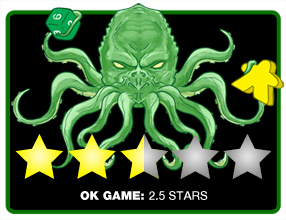 Since you were a small child, your dream has been to become the Master of the Senate. It’s right up there with exploring space, starring in a Broadway show, and becoming a tech billionaire. If you work smart enough, that dream is finally within reach.
Since you were a small child, your dream has been to become the Master of the Senate. It’s right up there with exploring space, starring in a Broadway show, and becoming a tech billionaire. If you work smart enough, that dream is finally within reach.
Political Animals is a 2-5+ player bidding, negotiation-style game where players will play as senators, competing to pass policies that advance their own political agendas. A standard game takes about 20 minutes.
Gameplay Overview:
Political Animals takes place over four rounds. In the center of the table will be a political grid, split up into four equal quadrants, representing four political ideologies. The quadrants are color-coded. For instance, the red quadrant represents socially and fiscally conservative, while dark blue represents financially and socially liberal. As you might expect, these two ideologies are on opposite ends of the grid. Each player is given an agenda card that corresponds to one of the political ideologies/quadrants on the grid.
The winner of the game will be the player whose quadrant has the Center of Gravity (CoG) token in it at the end of the game. The token will move or not move each round, depending on the results of policies that are voted on by all players.

Rounds are split up into four sections. First players will draw a number of political capital tokens as indicated by the round number. These tokens are what players will use to vote. Next, starting with the Presiding Officer, three total policies will be selected and rolled out. Each policy has a title, a thematic explanation, and a diagram showing how the CoG token will move if the policy is passed. During this section, any and all public discussion is allowed.
Players will then enter legislative session where any discussion can occur, including private meetings. Promises can be made but are not binding. Finally, the Presiding Officer can call for a vote at any time. At that point, all discussion must stop, and players will privately allocate their political capital (vote) tokens to YEA or NAY for each of the policies rolled out. Players can divide their tokens however they want.
Votes are then revealed and tallied. Any policy that received more YEAs than NAYs passes and the CoG token is moved accordingly. The first time a policy is passed it is flipped over to its level two side and put back into play for future rounds. Level two policies require two more YEAs than NAYs to pass but move the CoG farther than their level one counterparts. Any policy that does not pass is put back with the available policies and kept at the same level. If a player allocated zero political capital tokens for the round, they are given a rallying the base token, which counts as four political capital when played in the future.
Finally, the Presiding Officer token passes to the next player in clockwise order, and the next round begins. All unused political capital rolls over to the next round. After four rounds, the player with the agenda card matching the quadrant with the CoG token wins the game.

Game Experience:
I’ll start by saying this game has a bit of an identity crisis. My first impression from the box and the description was that this is a party game. I don’t know what else to think when I see that it’s a 20-minute negotiation game with some hidden roles that can accommodate “2-5+” players. Reading through the rules is quick and easy, furthering my suspicions that this is meant to be a quick romp with a strong focus on discussion.

In reality, this is moreso a bidding game than any other genre I could think of. Your political capital has to be spent (and saved) in just the right way. The discussion and negotiation are often inconsequential, so it comes down to mathing out victory and reading other players. In fact, there’s a rule which forbids a player from voting in the last round if they cannot mathematically win the game. That’s just one instance that screams to me that fun was not the main goal here. Let’s look past the presentation and first impressions and onto the gameplay.
The game itself unfolds in a surprising/awkward way. There’s not as much to discuss as you might expect. At least, it doesn’t come naturally like in other negotiation games. It is, in some ways, a zero-sum game. In a 4 player game, you have two potential allies and one player on the other side of the quadrant that wants the opposite of what you want. In the first round, everyone has the same exact bargaining chips. The differences in leverage between players becomes turn order. The first 3 players decide the policies to be voted on. If you are the 4th player, you can help someone pass their selected policy in hopes that they will repay the favor in a future round or just abstain and have more chips for later. I’d like to say that this is an interesting trade-off, but I don’t think it is. If the best strategy is sitting out for a quarter or more of the game, that’s just not enjoyable to me.

It does get more interesting after round one. Now, there is likely a clear leader. There may be an alliance or two made, but still, discussions don’t seem that valuable. Until someone takes a dominant lead and players must band together to stop them, you’ll vote YEA for policies that help you and maybe NAY on some policies that will hurt you. A meta definitely appears in the game after a couple of plays but in the standard 4 round game, you won’t see a large in-game meta unfold. It’s just too short for that. You will spend much of the game thinking to yourself what everyone else is going to bid, but you need to guess pretty accurately to succeed. If your policy gets beaten by even one vote in the opposite direction, all of the political capital you bid is completely wasted.
One major thing I want to discuss is just how many variants come in the box. Sure, added variety sounds great. However, in this case, it’s more like a hunt for the ideal way to play. Most combinations felt okay at best. If I wasn’t reviewing this game, I would not have played again after my first exposure to the standard rules. There are over 10 combinations of variants with little to no guidance on which to try first. I wish they would have narrowed it down to some essential elements instead of leaving it to the players to test it and find the best way to play. This complaint is not counting all of the potential player counts, many of which I would not recommend. I think the game only really works well at 4 and 5 players. And don’t get me started on the recommended 6+ player mode, which just means two people play as one. Nothing else changes for that variant. It’s lazy and I did not bother trying it.

The best way I found to play so far has been 5 players, long game, with amendments. The moderate political agenda adds more potential negotiations as they have an interest in keeping the CoG on one of the center squares. At this point, you are looking at a game that takes over 40 minutes. However, that allows for a meta to develop and long-term strategies to unfold. The amendment cards make it possible to scheme in fun and unique ways. They are a true game-changer. To me, the special ability cards were subtle and largely inconsequential. Some felt slightly stronger than others, but none felt game-changing. The hidden agenda variant sounds awesome, but ultimately adds a whole extra step each round that just bogs things down.
The theme of Political Animals is relevant and touchy. It’s almost “too soon” with the game being released the same year as the most contentious election in modern U.S. history. Many are looking for an escape from politics when they play games. I applaud the boldness of putting it front and center unapologetically. However, I do think it limits the audience that this game can be played with. On top of the fact that it is political in theme, it doesn’t really hide the political leanings of the design team. Again, fine by me, but it can limit the audience, or worse, cause some undesirable discussions at the game table.

Back to the identity of the game… the size of the box indicates some larger ambitions. The box has so much extra space in it that they put packing paper in the box to pad the components. I’ve never seen anything like this. The game components could have easily fit in a box half the size. Speaking of the components, they are fine. The cards and boards are plenty thick and the tokens are hard plastic/thick cardboard. The quality is high enough to not get in the way. The art is minimal and functional. Again, it doesn’t get in the way, and I really appreciate that.
However, there is no gavel. This game needs a gavel. I seriously think that would have increased the fun factor of this game by about 50%. There’s plenty of room in the box and it just makes so much sense for both the theme and gameplay. I cannot understand how that was overlooked.
Final Thoughts:
This was such a difficult review to write. I’m not sure I can give a fair rating even after a bunch of plays. That’s how much of an enigma this game is. Political Animals looks so fun, light, and innocent, but it’s a head-scratcher. Some people were intrigued enough to play it again while others didn’t want to give it another chance. I can really see this one being polarizing if a larger audience gets past the theme and presentation. As a product, I don’t think this hits the mark. As a once or twice experience, maybe.
I want to say that everyone should try this, but I have to come back to all the variants. I found the one I like the best, but I can’t confidently say it’s the best for every player. To me, there needs to be a more definitive playstyle for this game to succeed. As I think about the potential of this more, I believe this system would work so great as a part of a megagame with 15-25 people playing individually (not the team variant). I do hope to see more iterations of this.
Final Score: 2.5 Stars – Political Animals is an interesting bidding game to try once or twice, but a head-scratcher of a product.
 Hits:
Hits:
• Teaching and playing are quick and easy
• Amendments add exciting twists and more intrigue
Misses:
• So many variants in the box, leaving players to dig for the best way play
• Negotiations don’t come naturally
• Most player counts aren’t very fun
• No gavel included





















